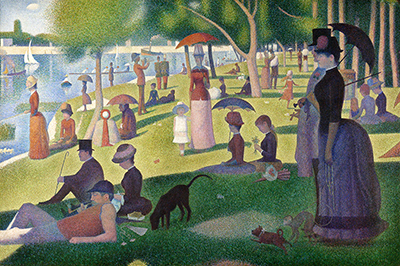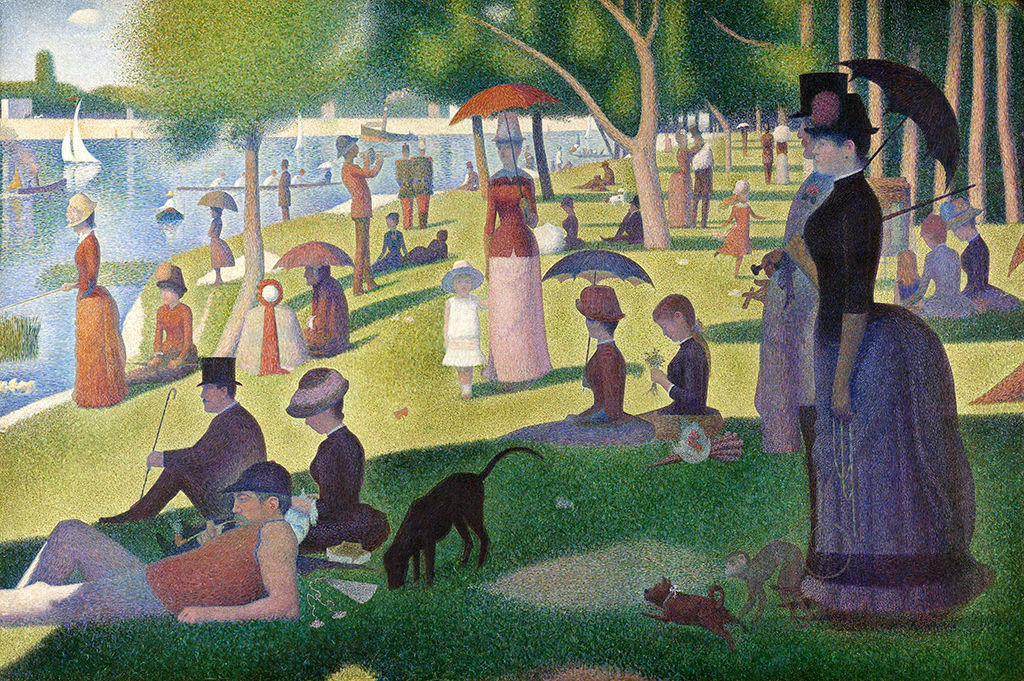It is generally accepted that Georges Seurat completed two masterpieces within his short but impressive career, namely Bathers at Asnières and also the artwork that we find here, A Sunday Afternoon on the Island of La Grande Jatte. The latter was completed between the years of 1884/86, as part of a major project.
The painting would become very much a labour of love for the artist who revisited it many times in order to tweak various elements of the composition. Seurat also produced several study pieces during its preparation in order to try out different ideas away from the main canvas. These were produced as oil sketches, where a lower level of detail is used so that the artist can work more quickly. There was also a number of drawings which were produced with charcoal and crayon that served to address other questions that still remained within the large oil painting's development. All of the key characteristics for which we most remember the career of this artist can be found within this painting - be it the depiction of French leisure time, the technical advancements with the luminosity of colour and also the bright palettes which he purposely strove for throughout his work in that medium.
If we take a look at the larger image of the completed painting at the bottom of the page, we will find a good survey of the detail included by Seurat. It is not really possible to get across the artist's Pointilist style without seeing it in person, as the series of dots are so complex that a digital image would not be able to replicate this unless it was at the same size as the original. We can, however, still make out an impression of this effect, with many of the surfaces within A Sunday Afternoon on the Island of La Grande Jatte being filled with series of colours that alternate ever so slightly each time. Subtlety was Seurat's essence, and we find that again within his Conté crayon drawings, where no part of the paper was left in either black or white, and everything was produced from a variety of shades of everything in between. With regards his paintings, the artist would not so much mix colours but rather place the two in neighbouring dots which tricked the eye into mixing them itself. He believed, having followed a number of different colour theories, that this approach would bring about a greater luminosity and he used it throughout the painting found here.
Georges Seurat was an important and influential artist who took elements of the Impressionist movement and pushed onwards with the addition of his own ideas. Although he did not see himself as doing so, he made use of a number of the characteristics of Impressionism, such as their tendency to work outside, or at least capture outdoor scenes. He also focused on the leisure pursuits in France at the time which was another key element to the Impressionists, as shown in the careers of Degas, Manet and Renoir. The impact of light and colour on the same objects in different conditions was also a major consideration in his work and can be connected to Monet's study series of Haystacks and Water Lilies, which came around a decade or so later. The use of colour theories in order to reach new levels of luminosity would come before two great minds of the 20th century (Klee and Kandinsky) who would also look deeply into this side of art, leaving behind their own publications of various related topics. Seurat himself would only live for around five years after A Sunday Afternoon on the Island of La Grande Jatte was completed, meaning that this work can probably be considered the heights of his talents.
The artist wanted to create a formula, if you like, on how to produce oil paintings such as these, and believed he could develop a mathematical approach to art. This flew in the face of the Impressionists, who themselves wanted artists to work as much from their feelings as from their technical expertise. This was perhaps the biggest difference between the two. Seurat hoped to construct each and every object within his paintings by following the principle of dotted spots of paint which together would create each form. This approach will remind some of Cezanne's paintings, as he also attempted to create a more consistent approach to painting than some of the other famous artists of this period. He would cover each element individually and then allow them to collectively form the overall composition by themselves. There are many facets to Seurat's style which link closely with today's world, such as with how he attempted to reduce everything down to a series of dots which is not really any different to the printed press or, indeed, the digital world. Some would reject this approach as being without any form of romance, but ultimately his finished paintings remain today amongst the most famous of all time.
Considering the composition itself, we find a plethora of middle class Parisiens relaxing by the side of the Seine river. There are nearly fifty figures within the scene in total, as well as a real sense of deep perspective which is one way in which this style diverges from Impressionism. The bank itself cuts across the artwork diagonally, increasing the sense of perspective. Seurat ensures that figures can be seen throughout this stretch of the bank, slowly getting smaller and smaller as we look further into the distance. Most of those we find here are either couples or families with young children. There are also a number of animals, too, including several dogs and a pet monkey. The work provides an interesting insight into the lives of these people during the late 19th century. There is also a number of small boats making their way along the river which adds to this calming sense of relaxation and happiness. Something to note is the relatively upright and formal nature of these figures, which gives off a sense of controlled enjoyment, where everyone is still confined to the norms of society.
If we look more closely into the individual figures within this painting, we can see several interesting activities going on. There is a long rowing boat making its way across the background, complete with four oarsmen and a cox. There is also a steam driven boat behind it on the other side of the river. Nearer to us is a tall, elegant lady dressed in red who appears to be enjoying a relaxed form of fishing. A child sits next to her, watching on in anticipation. Nearest us in the shade are several smartly dressed gentlemen, each with serious, formal expressions on their faces. They appear to be looking out across the river, content to take in other's activities out of curiosity, whilst also enjoying the panorama of this ideallic spot in the city of Paris. Further back as went move into the narrower part of the bank are children playing, though as the perspective shrinks down the size of these figures more and more, so the detail is harder to discern. Along the bank there are a number of trees dotted along the bank, though they are more intensively laid out further back, so that there is room for these people to enjoy the best part of this region.
At around the same time as this painting, Seurat also produced Bathers at Asnières, which focuses on residents on the opposing side of the river. Their dressing immediately helps us understand that the figures within that painting are of working-class origin, and their behaviour as a result is noticeably freer. It is therefore likely that these two works are essentially a collective comment on French society and would ideally be displayed together. It is examples like this that remind us of how well art can teach us about history and in a way that many find more interesting and accessible than perhaps some stale publications. In both paintings the figures seem fairly contented and relaxed, neither perhaps wishing for any great direction in their lives than they already have, but the ways in which they enjoy this leisure time is completely different. To see such a stark difference between the residents on one side of the river to the other is also incredibly illuminating and situations such as this are still entirely common within the western world all these years later.
"...Like all great masterpieces, La Grande Jatte continues to fascinate and elude..."
The Art Institute of Chicago
This highly significant artwork from the career of Seurat eventually made its way into the collection of the Art Institute of Chicago. The piece was initially loaned to the institution before being purchased outright in around 1924 for $24,000. It would now be worth very much in the tens, if not hundreds, of millions of dollars and its fame has also been extended by its appearance within a number of different television shows. Many members of the public will recognise this painting even though they would be completely unaware of the artist that produced it, in a similar way to a number of iconic artworks from the 19th and 20th century. These two depictions of life on both sides of the Seine have essentially risen beyond the fame of Seurat himself and established themselves very much in the mainstream media. Whilst they are undoubtably his two finest artworks, it would be wrong to stop at those, and within this website we draw together all the rest of his achievements during this relatively short but highly influential career.
The overall artwork took several stages before finally being completed. Seurat himself is known to have switched approach after initially using earth tones in 1884. He was readily mixing his paint at this time, and only moved on to his theory-led approach in the second stage which followed in 1885 to 1886. As such, you will find the characterstic dots being placed over the initial layers of paint, and the two made use of different tone of colour. In the final stage he would then look to add the final highlight touches, where certain elements would be brightened in order to bring them out a little more. This included touches of yellow paint for the areas of grass that were open to sunlight, as he wanted to provide a clear contrast between the shaded and unshaded parts of the painting. He finally painted the frame itself using alternative tones which attempted to draw out the colours of the main artwork even more. It was entirely unusual for painters from this period to make use of painted frames, but the practice has been used ever since the early to mid Renaissance era.





